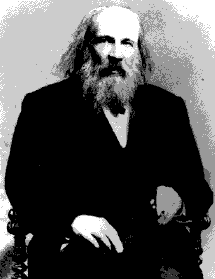In addition to his theoretical research, the application of science to industry and economics remained one of his primary concerns. He then worked (1859-60) at the University of Heidelberg, where he first collaborated with Robert Bunsen and studied capillary phenomena and the deviations of gases and vapors from the ideal gas laws. In 1860, Mendeleyev discovered the concept of critical temperature (see critical constants) and attended the first International Chemical Congress at Karlsruhe, where Stanislao Cannizzaro's views on atomic weights planted the seeds for the concept of the periodic table.
Mendeleyev served as professor of chemistry at the Saint Petersburg Technological Institute (1864-66) and at the University of Saint Petersburg (1867-90), a post that he resigned in protest against the administration's treatment of student petitions for reform. Because he found no suitable text for his students, he wrote his own--Principles of Chemistry (1868-71), which appeared in eight Russian, three English (the last, in 1905, reprinted in 1969), and several French and German editions. The systematization of ideas required for this book led Mendeleyev to formulate the periodic law in March 1869. The law organized the chemical elements known at the time according to their atomic weights and predicted the existence of more elements.
In subsequent years Mendeleyev refined and modified his law, which was received with considerable skepticism. After Paul Emile Lecoq de Boisbaudran, Lars Fredrik Nilson, and Clemens Winkler discovered the elements gallium (1875), scandium (1879), and germanium (1886), respectively--whose existence was predicted by Mendeleyev in 1871--the periodic law was universally accepted; Mendeleyev became famous and was showered with honors.
